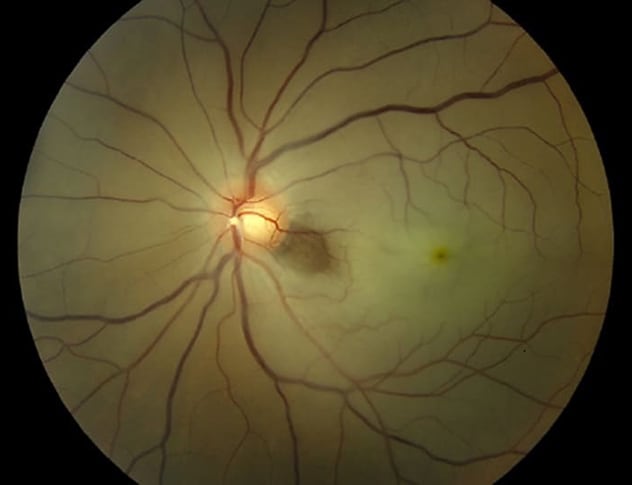Oct. 01, 2022
Central retinal artery occlusion (CRAO) affects 1 to 2 out of every 100,000 people each year, with 80% of patients experiencing a final visual acuity of 20/400 or worse. CRAO causes acute vision loss in the affected eye or eyes due to inner retinal ischemia.
مخاطر السكتة الدماغية الإقفارية

مخاطر السكتة الدماغية الإقفارية
انسداد حاد في شريان الشبكية المركزي
In addition to identifying debilitating vision loss, studies from Taiwan and Korea, published in the American Journal of Ophthalmology in 2012 and Ophthalmology in 2015, respectively, suggest that retinal artery occlusions are associated with an increased risk of ischemic stroke. Mayo Clinic researchers sought to further evaluate this risk.
"We recently looked at patients treated at Mayo Clinic and found that there was a 5% risk of symptomatic ischemic stroke within two weeks of CRAO. However, there can potentially be bias toward more-severe disease when looking at a tertiary center such as Mayo Clinic," says John J. Chen, M.D., Ph.D., a neuro-ophthalmologist at Mayo Clinic in Rochester, Minnesota. "Therefore, the goal of this study was to evaluate the risk of stroke at the time of a CRAO using a population-based cohort — via the Rochester Epidemiology Project — to help guide the discussion on how quickly a comprehensive cerebrovascular evaluation and work-up should take place in patients with CRAO."
This study assessed the risk of stroke, transient ischemic attack (TIA) and transient monocular vision loss (TMVL) in the 15 days before and after CRAO using the Rochester Epidemiology Project. Eligible participants were over 18 years old and had a CRAO while living in Olmsted County, Minnesota, between January 1, 1976, and September 9, 2016.
Methodology
The purpose of this study was to analyze population-based data to study the correlation between CRAO and incidence of stroke. Patient charts were reviewed retrospectively. Information gathered included:
- Patient gender
- CRAO laterality
- Age at diagnosis
- Cause of CRAO
- Ischemic or hemorrhagic stroke within 15 days before or after CRAO
- TIA within 15 days before or after CRAO
- TMVL within 15 days before or after CRAO
The study was published in Ophthalmology, the journal of the American Academy of Ophthalmology.
Systemic comorbidities were identified and visual acuity was measured at initial presentation of CRAO and one year following the diagnosis. The median age of participants was 76 years, 56.2% were male and 89.9% were white.
Racial demographic discrepancies can limit the general applicability of study results, and there are challenges in reviewing retrospective data, particularly when a study spans several decades, because there are changes in diagnostic evaluations, treatment, follow-up and technological advancements over time. However, this study has the benefit of being population based. Its results therefore avoid the potential referral bias that can occur in tertiary centers.
"It is important for clinicians, health care leaders and the public to understand the implications of CRAOs not only for vision but for neurological health and stroke as well. We hope these results can help inform the discussion as standards of care are optimized for the management of CRAO," says Kevin D. Chodnicki, M.D., a neuro-ophthalmologist and assistant professor of ophthalmology at Mayo Clinic in Rochester, Minnesota.
Results
Among 89 study participants with CRAO, 3.4% had a stroke the same day or within 15 days after CRAO, with 2.2% having ischemic strokes and 1.1% having hemorrhagic strokes. The occurrence of these strokes indicates a significant increase when compared with the anticipated number of strokes over a 30-day period using age- and gender-specific stroke incidence rates for Olmsted County.
"This population-based study confirms that there is a small increased risk of symptomatic stroke around the time of a CRAO, which makes sense because the pathophysiology for both CRAO and CNS stroke is usually thromboembolic disease," Dr. Chen explains.
According to this study, the risk of symptomatic ischemic stroke is 2.2% in the 15 days before and after a CRAO within a population-based cohort. This risk is slightly lower than that of most other studies from tertiary centers. The study's data can be used in the discussion of standards of care for the work-up, management and treatment of people with acute CRAO.
For more information
Chang YS, et al. Retinal artery occlusion and the 3-year risk of stroke in Taiwan: A nationwide population-based study. American Journal of Ophthalmology. 2012;154:645e652e641.
Park SJ, et al. Risk and risk periods for stroke and acute myocardial infarction in patients with central retinal artery occlusion. Ophthalmology. 2015;122:2336e2343e2332.
Chodnicki KD, et al. Stroke risk before and after central retinal artery occlusion: A population-based analysis. Ophthalmology. 2022;129:2.
Refer a patient to Mayo Clinic.